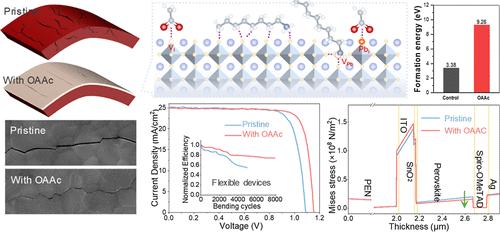Mechanically Resilient and Highly Efficient Flexible Perovskite Solar Cells with Octylammonium Acetate for Surface Adhesion and Stress Relief
IF 15.8
1区 材料科学
Q1 CHEMISTRY, MULTIDISCIPLINARY
引用次数: 0
Abstract
Flexible perovskite solar cells (FPSCs) have advanced significantly because of their excellent power-per-weight performance and affordable manufacturing costs. The unsatisfactory efficiency and mechanical stability of FPSCs are bottleneck challenges that limit their application. Here, we explore the use of octylammonium acetate (OAAc) with a long, intrinsic, flexible molecular chain on perovskite films for surface adhesion and mechanical releasing. The results showed that OAAc with high structural flexibility and strong molecular interactions can act as a mechanical release layer in releasing residual tensile stress, confirmed by the film and device characterizations as well as finite-element simulation. Moreover, the passivation of the OAAc could increase the formation energy of defects including I vacancy, Pb vacancy, and Pb–I antisite. The experimental results showed that the trap states of perovskites were significantly suppressed after OAAc modification, which is beneficial to the construction of high-quality films. With a high open-circuit voltage of 1.196 V, the efficiency of the OAAc-treated devices increased from 23.14% to 25.47% on a rigid substrate (23.12% on a flexible substrate), yielding superior long-term and mechanical durability. The corresponding flexible device retains 74% of the initial value even after 8000 bending cycles at a bending radius of 5 mm.

机械弹性和高效柔性钙钛矿太阳能电池与醋酸辛胺的表面粘附和应力消除
柔性钙钛矿太阳能电池(FPSCs)由于其优异的单位重量功率性能和可承受的制造成本而取得了显著的进步。fpsc的效率和机械稳定性不理想是限制其应用的瓶颈挑战。在这里,我们探索了在钙钛矿薄膜上使用具有长、固有、柔性分子链的醋酸辛基铵(OAAc)进行表面粘附和机械释放。结果表明,具有高结构柔韧性和强分子相互作用的OAAc可以作为释放残余拉伸应力的机械释放层,薄膜和器件表征以及有限元模拟证实了这一点。此外,OAAc的钝化可以提高缺陷的形成能,包括I空位、Pb空位和Pb - I对位。实验结果表明,OAAc改性后,钙钛矿的陷阱态明显受到抑制,有利于制备高质量的薄膜。在1.196 V的高开路电压下,oaac处理的器件在刚性衬底上的效率从23.14%提高到25.47%(在柔性衬底上提高到23.12%),具有优异的长期和机械耐久性。在弯曲半径为5mm的情况下,即使在8000次弯曲循环后,相应的柔性装置仍保持74%的初始值。
本文章由计算机程序翻译,如有差异,请以英文原文为准。
求助全文
约1分钟内获得全文
求助全文
来源期刊

ACS Nano
工程技术-材料科学:综合
CiteScore
26.00
自引率
4.10%
发文量
1627
审稿时长
1.7 months
期刊介绍:
ACS Nano, published monthly, serves as an international forum for comprehensive articles on nanoscience and nanotechnology research at the intersections of chemistry, biology, materials science, physics, and engineering. The journal fosters communication among scientists in these communities, facilitating collaboration, new research opportunities, and advancements through discoveries. ACS Nano covers synthesis, assembly, characterization, theory, and simulation of nanostructures, nanobiotechnology, nanofabrication, methods and tools for nanoscience and nanotechnology, and self- and directed-assembly. Alongside original research articles, it offers thorough reviews, perspectives on cutting-edge research, and discussions envisioning the future of nanoscience and nanotechnology.
 求助内容:
求助内容: 应助结果提醒方式:
应助结果提醒方式:


